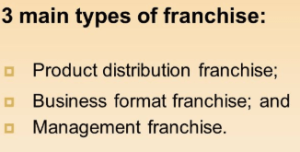Business and Economy
Types of franchises
 What is franchise?
What is franchise?
A franchise is understood to be a system where two people or, failing that, parties, start working together when the “franchisor” allows the other party to use their business system and brand, in exchange for a payment. The main types of franchises are job franchises, product franchises, business format franchises, investment franchises, and conversion franchises.
List of Franchises:
Here’s The franchises list:
- Job-Franchises
- Product Franchises
- Business Format Franchises
- Investment Franchises
- Conversion franchises
- distribution franchises
- management franchises
Types of franchises
The franchises can be classified as:
-The right they assign :
- Industrial: in this case rights are accessed in terms of technology, factory methods, production trade, that is, the production method must respect certain standards. These types of franchises turn out to be very high costs. They are used in the production of food, beverages, clothing, among others.
- Commercial: these franchises are used to exploit the sale of the final products. This is the simplest way and has great advantages since it allows you to use the brand’s exclusivity. Some examples are cosmetics (perfumery), food businesses (supermarkets, prepared or frozen foods), telecommunications (cell phones, small appliances), footwear, among many others.
- Services: this type of franchise is dedicated to providing all kinds of services. Some examples are courier, travel, real estate agencies, beauty centers, consultancies, sports or exercise centers, clubs to rent movies, among many others.
- Restaurants: within the scope of franchises this is the most important since it is very popular. Advertising takes on a fundamental character. Some examples are fast food, hamburger, confectionery, specialized or traditional restaurants, chocolate, ice cream, light or vegetarian food.
According to who accesses the franchise:
- Investment: it is the least used. In this case, the investors, that is, those who access the franchise, are not present in the management of the franchise, they only act as directors and supervisors, but only partially.
- Management: in this case, the franchise is professionally run, but whoever has accessed it does not need to manage it all the time. They are used to expand previous businesses.
- Self-employment: this is the most used. In this case, those who access the franchise dedicate their working life to managing it. In general, these people must dedicate a large part of their time to work and possess the ability to direct staff and interact with the franchisor.
They can also be classified by the type of contract used:
- Master: franchises are used in these contracts to be able to progress and open new cedes in places far from the master, that is, the first store that came into operation. In this case, the periods to use the franchises are usually long term. They are usually very expensive investments and are normally used to exceed national borders. The advantages they provide not only refer to access to markets that are not affordable due to distances, but are also useful for the use of new resources and do not require high levels of direction and control.
- Individual: this type of contract is the most frequent. Whoever accesses the franchise right can open a single headquarters, and is usually exploited by the same person. Generally, there are no failures here.
- Development areas: in this case, it is possible for the same person to be able to operate several sites simultaneously. One of the advantages of the franchisor is that they only have to maintain relationships with a single person, which can also be very risky, which is why they are not widely used.
Top Franchises in USA:
- McDonald’s
- Dunkin’
- Sonic Drive-In
- Taco Bell
- The UPS Store
- Culver’s
- Planet Fitness
- Great Clips